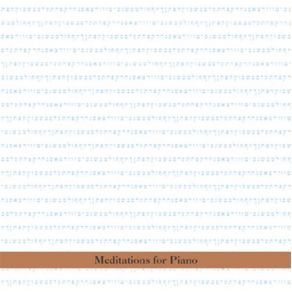Meditation for Piano
Download links and information about Meditation for Piano by Borah Bergman. This album was released in 2003 and it belongs to Jazz, Avant Garde Jazz, Avant Garde Metal, Classical genres. It contains 7 tracks with total duration of 46:26 minutes.

|
|
|---|---|
| Artist: | Borah Bergman |
| Release date: | 2003 |
| Genre: | Jazz, Avant Garde Jazz, Avant Garde Metal, Classical |
| Tracks: | 7 |
| Duration: | 46:26 |
| Buy it NOW at: | |
| Buy on iTunes $9.99 | |
| Buy on iTunes $9.99 | |
Tracks
[Edit]| No. | Title | Length |
|---|---|---|
| 1. | Meditation 1 | 3:09 |
| 2. | Meditation 2 | 12:46 |
| 3. | Meditation 3 | 7:06 |
| 4. | Meditation 4 | 7:30 |
| 5. | Meditation 5 | 7:24 |
| 6. | Meditation 6 | 6:57 |
| 7. | Meditation 7 | 1:34 |
Details
[Edit]This is perhaps the most uncharacteristic album of Borah Bergman's 30-year career as a vanguard pianist and composer. Issued as part of Tzadik's Radical Jewish Culture series, Meditations for Piano is a collection of seven compositions, ranging in length from just under two minutes to nearly 13, in which age-old Cantorial songs and their chants are referenced as source material. The word "reference" is key here. Even in their nocturnal grace and Eastern-tinged harmonics, these are Bergman compositions, pure and simple. A deep and very complex melodic structure is placed against a flowing sense of rhythm and nuance, where texture, tension, and architecture are applied in equal measure. Perhaps nowhere is this more evident than in "Meditation 2," where a series of four chorded phrases are interchangeably used in repetition against droning figures and minor ninths, sevenths, and thirds, collapsing into one another to move the piece to another level. Everywhere is the notion of space, between notes, lines, phrases, and whole sections placed in front of the listener in order to navigate, or more accurately "reflect," her way through the album. The clustered forth that introduces "Meditation 4" is broken down immediately into single notes, which form a songlike melody that evokes a gentle call and response before the chord is restated. The development of the piece lies in how the chord is extended and extrapolated upon in the melodic sequentia. Finally, it is revealed in "Meditation 7" that these chords have been the root of the entire program, as Bill Evans used them on Moonbeams, to introduce concepts of harmonic architecture subtly and dynamically with muted pedal work and hushed lines that nonetheless create the very essence of song. In this case, these are ghost songs that come from the nocturnal, sacred, and grieved imagination of the composer, who brings the tradition home to meditate on the present and future. This is Bergman as never before heard and at his most astute and lyrical despite his amazing use of angels and reversals. Brilliant.